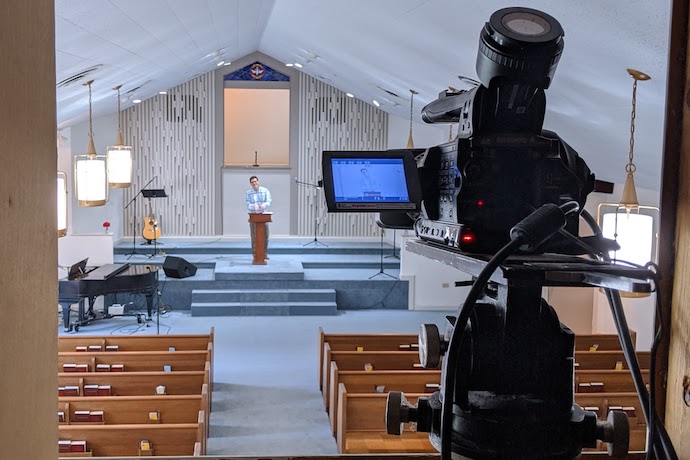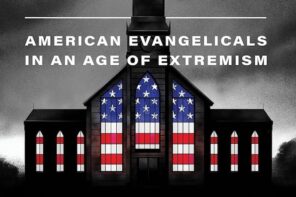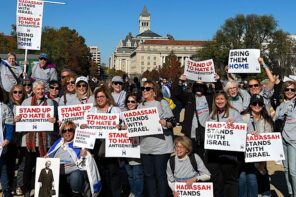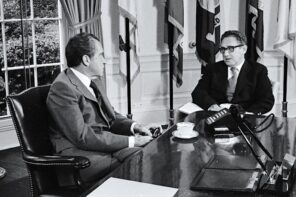Across the nation, stay-at-home orders have quieted downtowns, schools, theaters, and stadiums. But one kind of gathering space—the house of worship—has proven especially contested ground. Directives to suspend religious meetings have met with both resignation and protest. Suggestions to live-stream services at home have satisfied some worshipers but frustrated others who insist that communal prayer is essential.
But it hasn’t always been this way. For much of American history, worship at home—in addition to or even instead of church—has been the rule rather than the exception. By staying home in this crisis, American worshipers might well revive and reinvigorate the longstanding tradition of household religion.
The clergy and laity alike have struggled with stay-at-home rules, which many argue violate religious liberty. New York’s Hasidic Jewish community continued to hold weddings, funerals, and even a Purim carnival after other Jews had suspended these activities, because orders to stop seemed reminiscent of antisemitism and persecution. Just this week, the Hasidic community cried foul when New York City Mayor Bill DeBlasio sent the NYPD to break up a funeral procession in which thousands of people packed the streets to mourn Rabbi Chaim Mertz.
Meanwhile, pastors in Kentucky and Texas have sued to prevent the “unconstitutional application” of restrictions that violate church members’ religious freedom. Rev. Tony Spell of the Life Tabernacle Church near Baton Rouge, Louisiana, has repeatedly disobeyed Gov. John Bel Edwards’s stay-at-home orders by holding church services, sometimes busing in hundreds of people to attend. “I pray,” he told worshipers, “that the spirit of God will reveal … that I’m exercising my First Amendment rights and my freedom of worship.”
Surely, giving up public worship can be a painful sacrifice. But it’s also an opportunity to tap into a practice that’s deeply rooted in American culture: household religion.
Household worship has a long history. Puritans, who had congregated in private houses in England to avoid persecution, continued their boisterous conversations and solemn prayer meetings inside New England homes. The Church of England revolved more around church practice and liturgy, but Anglican institutions were weak in the colonies. In the 1670s, a handful of Anglican clergy served over 35,000 Virginian parishioners. In South Carolina, only one Anglican priest worked outside the city of Charleston by 1700. The population was so dispersed and the clergy so scarce that household worship was the most sensible approach.
Intolerance also pushed religious life inside the home. When Sephardic Jews arrived in New Amsterdam in the 1650s, local authorities instructed them to “exercise in all quietness their religion in their houses.” Maryland, though founded as a haven for Catholics, ultimately banned Catholic churches as the Anglican majority gained power. The colony’s Jesuit priests, barred from tending parishes, could still minister to “private Familyes,” as one priest confirmed in 1727. They traveled on horseback, concealing portable chalices in their saddlebags and offering the sacraments at home altars and in small proprietary chapels until growing toleration after American independence made public worship possible.
Persecution wasn’t the only reason to seek spiritual shelter at home; household worship wasn’t merely a second choice, considered inferior to congregational worship. Household religion actually became an institution in and of itself that molded family relationships and tied households to church and state. As Vermont’sWindham Ministerial Association proclaimed in 1803, “family government is the basis of all government, and family religion of all religion.” Household prayer—part obligation, part spiritual impulse—undergirded the social and political order.
Clergy guided families’ efforts with guidebooks for worship: prayers, hymns, and devotions; directions for leading Sabbath; and instructions for conducting funerals at home. Families typically designated space where parents catechized their children, neighbors gathered in prayer circles, and traveling ministers paid visits. During revivals, families hosted larger meetings in their houses, barns, and fields.
For Jews, mezuzot, kosher kitchens, and Shabbat candles reinforced faith’s presence. Enslaved people, who interwove African traditions with Christian practice, claimed sacred space by embedding charms and conjuring objects like needles, beads, and buttons in the floors and walls of their quarters and in coffins and grave sites.
The rhythms of the life cycle also demarcated sacred space at home. Childbeds and deathbeds became sites of prayer and conversion. A Bible placed on a laboring woman’s head might relieve her pain. Baptismal bowls stood on display in the house when not in use. Mourning jewelry and clothing reminded families of lost loved ones. Family Bibles, which contained records of births, marriages, and deaths, were passed on to favored relatives—usually women, who were keepers of the home as well as the Book.
So it continued, even as the forms of household religion changed. Nineteenth-century women crocheted and embroidered proverbs and devotional images and hung them on their walls. Families displayed ornately illustrated oversize Bibles on wooden stands that dominated their parlors like shrines. Architectural elements like gables, stained glass, and gothic arches were supposed to make homes feel like churches. Victorian houses included nooks and alcoves intended for prayer and quiet contemplation. Prayer around the table remained a feature of family life.
Meanwhile, religious leaders found new ways to reach people in their homes. In the nineteenth century, missionaries traveled from house to house, delivering religious texts and newspapers to support reading and prayer. In the twentieth century, Charles Fuller and Billy Graham pioneered radio and television. Children’s programming from Davey and Goliath to VeggieTales has offered Christian alternatives to more secular fare. In our own time, megachurches like the Southeast Christian Church in Louisville, Kentucky, and Rick Warren’s Saddleback Church in Orange County, California, have mastered digital technology, reaching churchgoers via social media, livestreaming, and podcasts. The internet revolution has taken hold on a smaller scale, as well. Idris Abdul-Zahir, an imam at the Masjidullah mosque in Philadelphia, began livestreaming Friday prayer services last year. All of this has meant that more people spend more time hearing sermons and praying in their homes.
For some denominations, household prayer isn’t merely an alternative but supersedes public worship. In 2018, the Church of Jesus Christ of Latter-day Saints officially reset the balance between home and church by shortening Sunday services and increasing the expected time spent on home gospel study, providing workbooks to support the effort.
***
And yet, despite the persistence of household religion, many people still equate freedom to worship with freedom to worship publicly. Why?
The reason likely lies with historical changes that have thrust religious institutions into the foreground. Sunday schools supplanted home catechism in the early nineteenth century. Catholics planted dioceses, parishes, and schools. Protestant revivals have triggered surges of church-building. Waves of immigration among Jews, Buddhists, and Muslims (and yet more Catholics) have paved the way for houses of worship, schools, clerical councils, and seminaries to serve these groups. Today’s churches, synagogues, and mosques function as all-purpose lifestyle centers as well as places of prayer, offering marriage counseling, workout facilities, affinity groups, retail shopping, summer camps, addiction and recovery programs, and community service projects. For these reasons, it’s no surprise that the faithful see their religious worlds as revolving around church rather than home.
The COVID-19 crisis has changed all of that.
A varied and often confusing patchwork of local and state emergency measures have included religious gatherings, either ending them altogether, limiting in-person attendance, or designating houses of worship as “essential” and allowing congregations to assemble unrestricted. Although a Pew Research Center study released this week found that most states allow public religious worship in some form, another poll found that only about 17 percent of the population is currently attending services. To add to the confusion, the guidelines are changing as some states and localities have begun to lift stay-at-home orders.
Most houses of worship, after adding social distancing measures in February, began to close their doors in early March while the clergy and laity scrambled to adapt. In many cases, that meant reconfiguring what churches were already doing for followers who are now staying home. The Prince of Peace Parish in Pittsburgh began broadcasting Catholic Mass on Facebook and YouTube and has released a series of podcast homilies called “Sermon in the ’Burgh.” Other churches have offered drive-up preaching and drive-through Communion. Throughout Ramadan, the Dar Al-Hijrah Mosque in Minneapolis has, for the first time, publicly broadcast its calls to prayer to the city’s Muslim community so they can pray in unity from home.
But in other cases, this transition has meant providing entirely new services. Temple Emmanuel, a Reform synagogue in Dallas, Texas, hosted a Zoom seder for 500 people, despite never having organized congregational seders before. The Unitarian Universalist Congregation of York (Pennsylvania) sponsors online workshops, virtual happy hours (“Pub Theology”) and online storytelling for children. Kveller, a Jewish news site, has partnered with My Jewish Learning, a cultural resource site, to connect readers with virtual Shabbat sing-alongs, Torah study groups, and Tehillim (psalm) readings.
Despite well-publicized lawsuits to fight church closures, many of the faithful seem to be accepting these changes. Weston Smith, who attends Restore Community Church, a non-denominational Protestant church in Kansas City, Missouri, reported that fellow churchgoers took the change in stride, understanding their short-term sacrifice in terms of their belief in “loving your neighbor.” His family’s religious routines have moved online, including Sunday worship, Bible study, and youth groups.
So many believers have rearranged their practice that the Center for the Study of Religion in American Culture has partnered with the Roy Rosenzweig Center for History and New Media to sponsor Pandemic Religion: a crowdsourced collection of images, videos, and other evidence of the religious response to the COVID-19 crisis. Contributors offer glimpses of spiritual life at home: makeshift communion tables, a Zoom LifeGroup meeting, reflections on Ramadan, and a Jewish prayer written for the pandemic. An anonymous contributor wrote that his or her family created “a sacred space” in their home, where they “have spent more time … doing [B]ible readings [and] praying” with hopes to “find peace throughout all of this and still stay connected with God.”
***
Despite these creative responses, obstacles to household observance abound. Some faiths require a quorum to hold prayer or ritual, which can be difficult to assemble now. In the Episcopal church, two people must be present for Holy Communion: the ordained celebrant and a recipient. Even though Episcopalians are encouraged to celebrate the Eucharist weekly, many dioceses have omitted the practice rather than attempt non-contact Communion.
In Jewish tradition, the most important prayers require a minyan (a quorum of ten adults). Congregations have attempted socially distanced minyans or online gatherings with mixed results. For Muslims, Salat al-Jumuah (Friday prayer) requires between three and forty men at minimum, depending upon the tradition. Imams have settled for virtual quorums. “As long as there are three people gathered together,” Idris Abdul-Zahir reminded his faithful in Philadelphia, “it’s a service”—even if those people are physically apart.
More practically speaking, many people lack the technology they need to join online services, and even when they do have access, the experience can be awkward. Brian Weiser, a Modern Orthodox Jew from Denver, tried an online minyan but Zoom conferencing made the ritual feel disjointed. He missed “the communal aspect” of the prayers and has continued that part of his practice alone. The Zoom interface can be both a blessing and a curse. Tracey Deutsch, who attends a Reform synagogue in Minneapolis, put it this way: “the nice thing about Zoom in terms of a congregation is that you get to see people’s homes.” On the other hand, “the bad thing about Zooming a congregation is that everyone can see my home, whatever state it’s in.”
Household worship in a pandemic is a constant reminder of what’s missing. Muslims, who are now observing Ramadan, typically break each day’s fast with a large, celebratory meal. These thanksgivings are impossible now. So are many mourning rituals. Weiser, along with Kate Carté, who attends Temple Emmanuel in Dallas, noted the difficulty of sitting shiva: the seven-day period of mourning after a burial, which typically takes place in the home of the deceased. Carté observed that rabbis were “really struggling to figure out ways to do … digital shiva,” although they’ve since devised some solutions. Weiser noted that Zoom shivas are “better than nothing, but you lose the sense of people sitting there, comforting you.”
Even weekly observance has posed difficulties. Margaret Hogan, who attends All Saints (Episcopal) Parish in Brookline, Massachusetts, typically assists with Sunday services but now participates from home. She reports a shared sense of loss among her co-parishioners. “I miss being a part of it,” she admits. For Hogan, church ranks high among “the things you could count on that have been deeply disrupted.”
***
Despite the disruptions it appears that some worshipers are more engaged than ever. Many people are finding that this period of quiet has energized their practice with new ways to worship. Jill Smith, a Modern Orthodox Jew from Cambridge, Massachusetts, attended a Zoom baby-naming service and joined in a virtual Birkat Hagomel, a thanksgiving prayer for surviving trauma, with a friend who recovered from COVID-19.
Rosie O’Brien Richards, who worships at the Redeemer Church of Montclair, New Jersey, has found that her ten-year-old daughter, who has sensory processing difficulties and hadn’t enjoyed going to church, participates eagerly now in the calm of their home. Many worshipers who are homebound due to age, illness, or disability now have unprecedented access to religious communities. Former parishioners who have moved away can reconnect with old friends. Others, like Michelle Orihel, a Catholic in Cedar City, Utah, and Andrea Catlett, an ecumenical Christian in suburban Denver, have taken this opportunity to sample virtual services and sermons at distant churches. “We’re not assembling in a place,” Catlett reflected, “but we’re assembling in the heart.”
The usual hassles of regular observance no longer pose obstacles. David Chang, Tracey Deutsch’s husband, now has time to bake challah for nearly every Shabbat, and their family participates in far more rituals than they had before. Chang describes this time as (literally and figuratively) “nourishing.” Allison Hart-Young, who attends a Reform Jewish synagogue and a United Church of Christ congregation in Kalamazoo, Michigan, observes that the ease of attending worship has allowed her to focus on its deeper significance. Without Friday evening traffic and the rush of getting ready on Sunday mornings, she and her wife can “strip [worship] down” to its core meaning and “clarify … what role this plays in our weekly life.”
According to Kate Carté, the pressure of Shabbat—preparing the house, clearing the family’s schedules, rushing through dinner on the way to synagogue—has lifted. Before, she recalls, “it was like a collapse into Shabbat.” But now, “this is the first time in my life … I’ve had the space” to make observance “more meaningful.” Now that her family is staying at home, “suddenly the ritual became a lot more important.” Perhaps this is why virtual attendance at services everywhere have far surpassed face-to-face participation prior to the crisis.
For many believers, unstructured days at home have allowed physical and mental space for greater devotion. Stacey Tew, a member of the Church of Jesus Christ of Latter Day Saints who lives in the Houston suburbs, appreciates that her family “can be together and learn the scriptures at a slower pace.” She describes home worship as a “spiritual experience” in which her husband can “bless and pass the sacrament” for her and their children.
Leonardo Leyva, who attends the nondenominational Embassy Church in Denver, believes that without the usual distractions, people’s “relationship with God has grown.” Michelle Orihel had been feeling ambivalent about her religious practice prior to the COVID-19 crisis, but daily prayer and meditation have eased anxiety and given her a measure of inner peace. “I see value in practicing religion on a daily basis,” she reflected, “and having a little more time on my own to focus.”
Whether by choice or compulsion, more people are finding more meaning in worshiping at home. Household religion in the pandemic will almost certainly alter the landscape of American faith, though it’s hard to say how deep or lasting the effects will be. All we know for sure is that, for now, family religion is meeting a need. “These are spiritually taxing times,” Tracey Deutsch observes. Household prayer, for people across a spectrum of affiliation and belief, has provided some solace.





